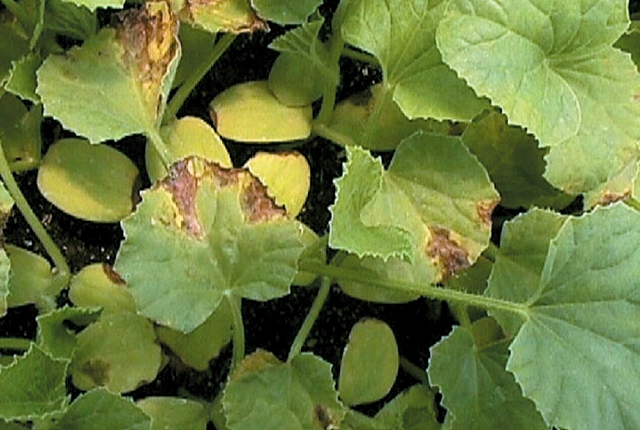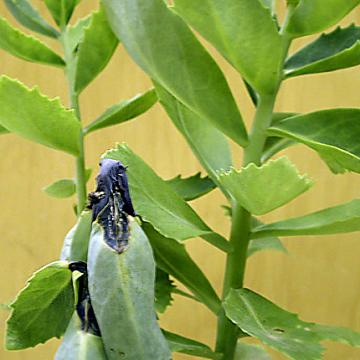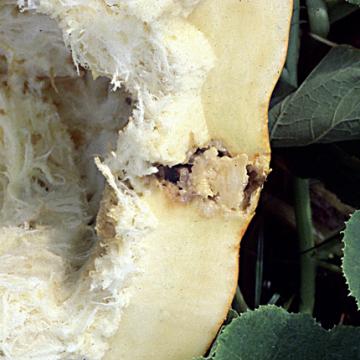DISEASE: Bacterial blight (rot) of sedum
HOST: Sedum
Water-soaked and decaying tissues at leaf base.

Bacterial blight (rot) of sedum | Sedum
DISEASE: Bacterial blight (rot) of sedum
HOST: Sedum (Sedum sp.)
PATHOGEN: Dickeya dianthicola
PATHOGEN SYNONYM: Erwinia chrysanthemi pv. dianthicola
SOURCE: M. Daughtrey
DISEASE: Bacterial fruit blotch
HOST: Cantaloupe
Early stage of disease with discolored blotches on the surface.

Bacterial fruit blotch | Cantaloupe
DISEASE: Bacterial fruit blotch
HOST: Cantaloupe (Cucumis melo var. cantalupensis)
PATHOGEN: Acidovorax citrulli
PATHOGEN SYNONYM: Acidovorax avenae subsp. citrulli
SOURCE: D. B. Langston
DISEASE: Bacterial fruit blotch
HOST: Cantaloupe
View of disease path from rind to internal rotting of melon.

Bacterial fruit blotch | Cantaloupe
DISEASE: Bacterial fruit blotch
HOST: Cantaloupe (Cucumis melo var. cantalupensis)
PATHOGEN: Acidovorax citrulli
PATHOGEN SYNONYM: Acidovorax avenae subsp. citrulli
SOURCE: R. Gitaitis
DISEASE: Bacterial fruit blotch
HOST: Cantaloupe
Leaf spot stage. Lesions start small and may coalesce, forming large, brown necrotic areas.

Bacterial fruit blotch | Cantaloupe
DISEASE: Bacterial fruit blotch
HOST: Cantaloupe (Cucumis melo var. cantalupensis)
PATHOGEN: Acidovorax citrulli
PATHOGEN SYNONYM: Acidovorax avenae subsp. citrulli
SOURCE: D. B. Langston
DISEASE: Bacterial wilt
HOST: Cantaloupe
Cantaloupe field with severe destruction from bacterial wilt (left), less on right.

Bacterial wilt | Cantaloupe
DISEASE: Bacterial wilt
HOST: Cantaloupe (Cucumis melo var. cantalupensis)
PATHOGEN: Erwinia tracheiphila
SOURCE: L. Claflin
DISEASE: Fire blight
HOST: Pluot
Fire blight cankers on major limb. Pluot is an interspecific hybrid of plum and apricot.

Fire blight | Pluot
DISEASE: Fire blight
HOST: Pluot (Prunus hybrid 'Dandy Dapple')
PATHOGEN: Erwinia amylovora
SOURCE: S. Mohan
DISEASE: Fire blight
HOST: Pluot
Dead shoot, the result of systemic infection.

Fire blight | Pluot
DISEASE: Fire blight
HOST: Pluot (Prunus hybrid 'Dandy Dapple')
PATHOGEN: Erwinia amylovora
SOURCE: S. Mohan










